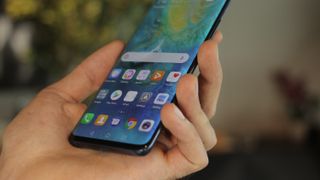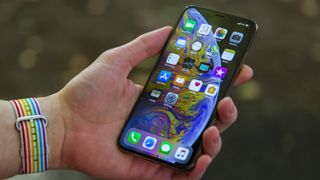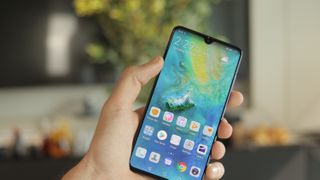Why you can trust TechRadar

Final Verdict
The Mate 20 Pro is a full-featured phone for a full-featured price, but it doesn’t skimp on the former. The device even has a few tricks you won’t see elsewhere, and more powerful specs than most of its competitors.
It’s a culmination of Huawei’s aspiration to put forth a phone that truly competes at the top tier, and it’s a shame that it isn’t available in more markets, including the US. If you’re willing to jump through hoops to acquire and activate the phone, it’s worth buying.
The Mate 20 Pro earns its spot going toe-to-toe against the other top smartphones, but it suffers from market absence and, admittedly, falls short in some areas. Despite having fewer lenses, the Google Pixel 3 offers a competitive camera experience at a notable discount, and the iPhone XS has iOS 12 tried and true ecosystem backing it up - including iMessage.
The Samsung Note 9 or Galaxy S9 Plus might be the closest competitors with the Mate 20 Pro, and it’s a near thing. Huawei’s phone has a slight edge in specs, but a weaker UI without Samsung’s great Android experience.
Who is this for?
Now that Huawei has priced the Mate 20 Pro around the cost of a Samsung Note 9 or iPhone XS, the company’s new flagship is no longer a more affordable choice among top-tier phones. Instead, it’s a device for anyone who needs top-of-the-line specs with a camera suite and features to back it up.
That said, you’re getting your money’s worth here: anyone willing to spend the coin will get a device that should last them years.
As with all smartphones, access and affordability varies depending on where you live. Some (non-US) carriers may offer deals that soften the financial blow of the Mate 20 line, especially with monthly offers. For example, the Australian carrier Optus is currently offering the 128GB Mate 20 Pro for AU$85/month with 50GB of data, while the same size Samsung Galaxy Note 9 is being offered for AU$95/month, making it the cheapest Android flagship the carrier offers.
Should you buy it?
The Mate 20 Pro is hitting the market at the same pre-holiday juncture as other phones, but it would be criminal to overlook this powerhouse in favor of brands that are more recognizable in your market. The Mate 20 Pro should satisfy anyone who wants a camera-focused performance machine, full stop.
If that’s you, and you’re willing to stomach a four-figure price tag, the phone won’t disappoint.
First reviewed: October 2018
Competition

Samsung Galaxy Note 9
The Samsung Galaxy Note 9 is meatier phone that comes packed with comparable specs (6GB RAM, starting at 128GB storage) to the Mate 20 Pro, though its Snapdragon 845 is slightly less advanced. The Note 9 also comes with its signature stylus, which has been upgraded with an interactive button to trigger the phone camera’s shutter, along with other functionality. Its 6.4-inch screen is crisp and curved, just like the Mate 20 Pro. If Huawei’s new phone isn’t easy to acquire or if its interface isn’t to your liking, the Samsung Note 9 is a good Android alternative.
Full review: Samsung Galaxy Note 9 review

iPhone XS Max
The iPhone XS Max is Apple’s larger flagship, and while it’s not the biggest phone on the block, it’s certainly powerful. The 6.5-inch OLED display is crisp, though its 458ppi pixel density isn’t quite as high as the Mate 20 Pro. Its two-camera suite lacks the Mate 20 Pro’s telephoto lens, but in our testing, the iPhone XS Max had noticeably better HDR capabilities. Otherwise, Apple’s phone packs the company’s newest A12 processor, a 7nm powerhouse that rivals the Kirin 980 in sheer oomph. But what you should probably dither over more is whether you’re happy with Huawei’s minimalist Android load, or if you want to go full iOS.
Full review: iPhone XS Max review

Huawei Mate 20 / Mate 20 X
Those who can live without the Mate 20 Pro’s fancier bells and whistles should be more than happy with the vanilla Mate 20. It packs the same powerful Kirin 980 processor and an ever-so-slightly downgraded camera suite, as well as a slightly larger 6.53-inch, lower-resolution FHD+ RGBW screen. It doesn’t have an in-screen fingerprint scanner or reverse charging, but for fewer tricks, you can get the best parts of the Mate 20 Pro at a hefty discount.

Sitting between the Mate 20 and Mate 20 Pro in price is the colossal Mate 20 X, which is marketed toward gamers but should suit anyone who craves a performance phablet rather than the thinner, longer Mate 20 Pro. Its 7.2-inch OLED display is the same FHD+ resolution as the vanilla Mate 20, but it’s still a fine screen. With an enormous 5,000mAh battery, dedicated vapor chamber-plus-graphene cooling system and control stick peripheral, this is a media-consuming machine, if that’s what you’re looking for.
Full review: Huawei Mate 20 review
David is now a mobile reporter at Cnet. Formerly Mobile Editor, US for TechRadar, he covered phones, tablets, and wearables. He still thinks the iPhone 4 is the best-looking smartphone ever made. He's most interested in technology, gaming and culture – and where they overlap and change our lives. His current beat explores how our on-the-go existence is affected by new gadgets, carrier coverage expansions, and corporate strategy shifts.

Wear OS 5: what we want to see, and all the leaks so far

The obscure little PC that wanted to be a big NAS — super compact Maiyunda M1 doesn't cost that much, offers up to 40TB SSD storage, runs Windows and has 4 Gigabit Ethernet ports

Image site Abload going offline reminds me of how much online content we've permanently lost

